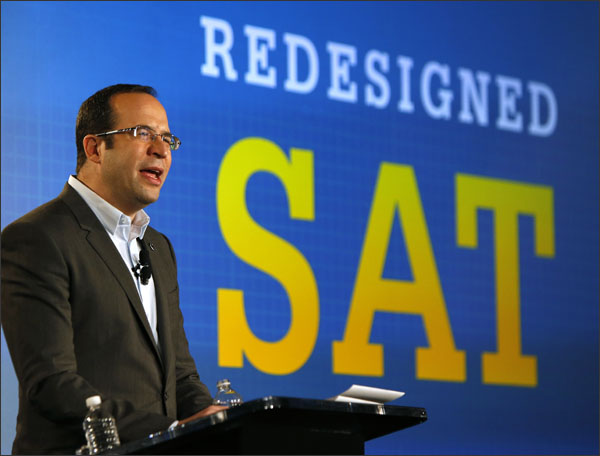How to Prepare for the New SAT’s Reading Comprehension
 You’ve most likely heard by now that the New SAT has come out with changes that many are surprised are possibly making the test easier. In particular, some are saying the reading comprehension section is less difficult than before.
You’ve most likely heard by now that the New SAT has come out with changes that many are surprised are possibly making the test easier. In particular, some are saying the reading comprehension section is less difficult than before.
However, despite all this “rhetoric,” most students aren’t prepared for the Reading Comprehension section for the exam many top colleges still require for admissions. As a result, we at SanLi have decided to share some of our secrets for the general community out there on how to prepare for possibly the most challenging part of the exam.
#1 Tip: Truly Understand the SAT Exam
Have you heard of David Coleman? Besides graduating from an Ivy League University, there is a bit more about the man you should know about to understand more about the changes to the SAT.
In 2009 the National Governors Association and the Council of Chief State School Officers launched an initiative to write Common Core State Standards for elementary through high school English Language Arts and Mathematics. The Common Core State Standards aim to prepare students for college and careers by identifying the skills students should learn from kindergarten through high school. David Coleman was on the English Language Arts writing team, which was chaired by Student Achievement Partners co-founder Sue Pimentel. Coleman’s friend and Student Achievement Partners co-founder Jason Zimba was a leader on the Mathematics writing team. As of June 2014, the standards have been adopted by 44 states. Other states have not adopted the standards, or have adopted them temporarily then later backed away from adoption.
Yes, David Coleman was a huge part of the Common Core. On top of that, if you pay attention closely to the “Common Core,” you’ll see many things you’ve been told about the New SAT originally mentioned by the standard many U.S. States have adopted into their curricula.
For example, on the “Key Shifts in English Language Arts” page, you’ll see the type of content in the first tenet about reading more “complex texts” to focus on the “academic language.”:
The standards include certain critical types of content for all students, including classic myths and stories from around the world, foundational U.S. documents, seminal works of American literature, and the writings of Shakespeare.
With regards to what the SAT says, they tell us that “The Reading Test always includes”:
- One passage from a classic or contemporary work of U.S. or world literature.
- One passage or a pair of passages from either a U.S. founding document or a text in the great global conversation they inspired. The U.S. Constitution or a speech by Nelson Mandela, for example.
- A selection about economics, psychology, sociology, or some other social science.
- Two science passages (or one passage and one passage pair) that examine foundational concepts and developments in Earth science, biology, chemistry, or physics.
Does anything look familiar?
The second tenet of the common core says another “key shift” will be:
Reading, writing, and speaking grounded in evidence from texts, both literary and informational
On the College Board’s website, you’ll see even more language that is consistent between both organizations:
What the Reading Test Measures
…
Command of Evidence
Some questions ask you to:
- Find evidence in a passage (or pair of passages) that best supports the answer to a previous question or serves as the basis for a reasonable conclusion.
- Identify how authors use evidence to support their claims.
- Find a relationship between an informational graphic and the passage it’s paired with.
So, the next question may be: “What texts will give me all of that?”
First of all, we’ve been devising an incredible curriculum around much of the content a year before the exam was released. Our “founding documents” curriculum is second to none. It may be why many of our students have scored above 1500 on the new exam.
Secondly, as our Academic Head in Hong Kong has written already, you should examine the practice exams already provided. He wrote in the top Q&A website in the world:
“If you check out the 4 available SAT sample exams online, you can easily check out the sources of the material provided on the reading test. Just look at the excerpt up top. They are for Practice Test 1:
- Virginia Woolf, Three Guineas. ©1938 by Harcourt, Inc.
- Lydia Minatoya, The Strangeness of Beauty. ©1999 by Lydia Minatoya
- Francis J. Flynn and Gabrielle S. Adams, “Money Can’t Buy Love: Asymmetric Beliefs about Gift Price and Feelings of Appreciation.” ©2008 by Elsevier
- J. D. Watson and F. H. C. Crick, “Genetical Implications of the Structure of Deoxyribonucleic Acid.” ©1953 by Nature Publishing Group. Watson and Crick
- Michael Slezak, “Space Mining: the Next Gold Rush?” ©2013 by New Scientist. Passage 2 is from the editors of New Scientist, “Taming the Final Frontier.” ©2013 by New Scientist”
If you need more ideas, come by to our center and we’ll give you more recommendations. We will be happy to help you with our SAT Courses or even just a quick conversation about the new exam.
